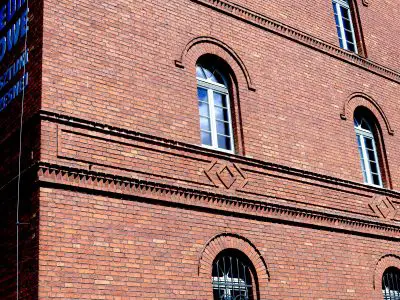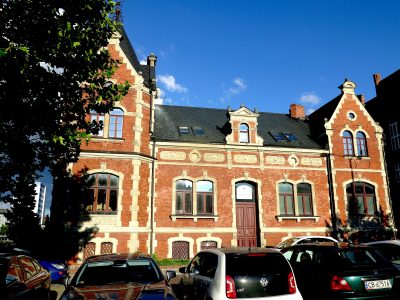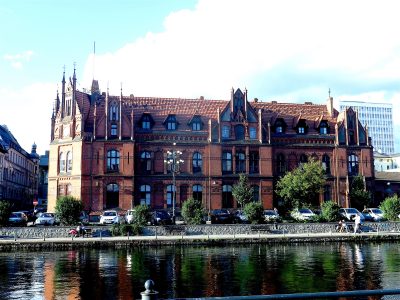There’s a question I’ve wondered about for years and I’ve never yet found a good answer. Millions of us live in the richest time in history and we have the best, fastest and most efficient manufacturing and construction tools the world has ever known. Yet despite this, we often choose easier, simpler, less beautiful, less durable building options than they did years ago when life was harder. Why is this? Even today’s multi-millionaires often live in homes that are not nearly as beautiful or well crafted as was common among the rich a hundred or more years ago. I’m puzzled.
I’m also reminded of this strange situation whenever I travel to places with more history than the average North American suburb. More often than not, the differences I see plainly come back to masonry, and especially bricks. There are three lessons old bricks can teach us:
Lesson#1: Build Three Dimensionally
 The nicest brick work in the world is never just flat. Sure, all brickwork has flat sections, but there are also plenty of areas that extend beyond the face of walls to create patterns, shadows and classical effects that hardly ever happen to the same extent in modern buildings. The practice of creating brick and stonework that extends beyond the faces of walls is called “corbeling”, but why do I never see it happen the way it used to?
The nicest brick work in the world is never just flat. Sure, all brickwork has flat sections, but there are also plenty of areas that extend beyond the face of walls to create patterns, shadows and classical effects that hardly ever happen to the same extent in modern buildings. The practice of creating brick and stonework that extends beyond the faces of walls is called “corbeling”, but why do I never see it happen the way it used to?
The usual answers go something like this: “Quality costs too much” or “tradespeople just aren’t that skilled any more” or “clients won’t pay for it”. Ideas like these seem reasonable at first, but not after a little thought. Why could poorer societies of centuries ago afford generous beauty while we claim we can’t? And why could these older societies also train ordinary people to do extraordinary masonry work when information technology should now make it easier than ever to train people and make them great with their hands?
Lesson#2: Build With Colour
 Too many exterior walls these days are all the same colour, and the options for using colour for design purposes is especially rich when it comes to brick. It’s rare to find an older brick building that’s all one shade. Instead, there are usually two ways different colours of brick were intentionally used. First, lighter brick can be found highlighting corners, window openings and door openings. Also, brick with three or four shades of colour can be used randomly throughout the wall to create a mottled and organic effect. Both these things are common in older buildings, but hardly seen today. Is this really because it’s too much trouble?
Too many exterior walls these days are all the same colour, and the options for using colour for design purposes is especially rich when it comes to brick. It’s rare to find an older brick building that’s all one shade. Instead, there are usually two ways different colours of brick were intentionally used. First, lighter brick can be found highlighting corners, window openings and door openings. Also, brick with three or four shades of colour can be used randomly throughout the wall to create a mottled and organic effect. Both these things are common in older buildings, but hardly seen today. Is this really because it’s too much trouble?
Lesson#3: Build With Generous Style
 Bydgoszcz is a small city in Poland, and in 1883 the government there built a post office along the river that runs through the community. What could be more practical than a post office, right? What better excuse to spend as little as possible to create nothing more than a plain, utilitarian structure for the sorting of letters and delivery of packages? This is the kind of thinking behind many new buildings in our world today, and our landscape bears the scars. But this certainly wasn’t the thinking of the decision makers in Bydgoszcz 130 years ago. That’s the “post office” to the left. It’s strikingly beautiful by North American standards, yet just one of many buildings like it in Europe.
Bydgoszcz is a small city in Poland, and in 1883 the government there built a post office along the river that runs through the community. What could be more practical than a post office, right? What better excuse to spend as little as possible to create nothing more than a plain, utilitarian structure for the sorting of letters and delivery of packages? This is the kind of thinking behind many new buildings in our world today, and our landscape bears the scars. But this certainly wasn’t the thinking of the decision makers in Bydgoszcz 130 years ago. That’s the “post office” to the left. It’s strikingly beautiful by North American standards, yet just one of many buildings like it in Europe.
Why does all this matter? Just one reason as far as I can tell. It comes down to a decision we can’t avoid making as individuals and as a society. We can choose to build places where real beauty is present in generous quantities to cheer our day and lighten our hearts. Far poorer societies than ours did much better than we do. Or we can settle for more plain, practical, boring and soul-starving structures that are already too common today. Which way of life is better? Just look at the kind of places people travel to from all over the world to be refreshed on vacations and you’ll find places with the kind of genuine, classically beautiful buildings that teach lessons taught by old bricks laid with skill, passion and good taste. Shouldn’t these old bricks tell us something?